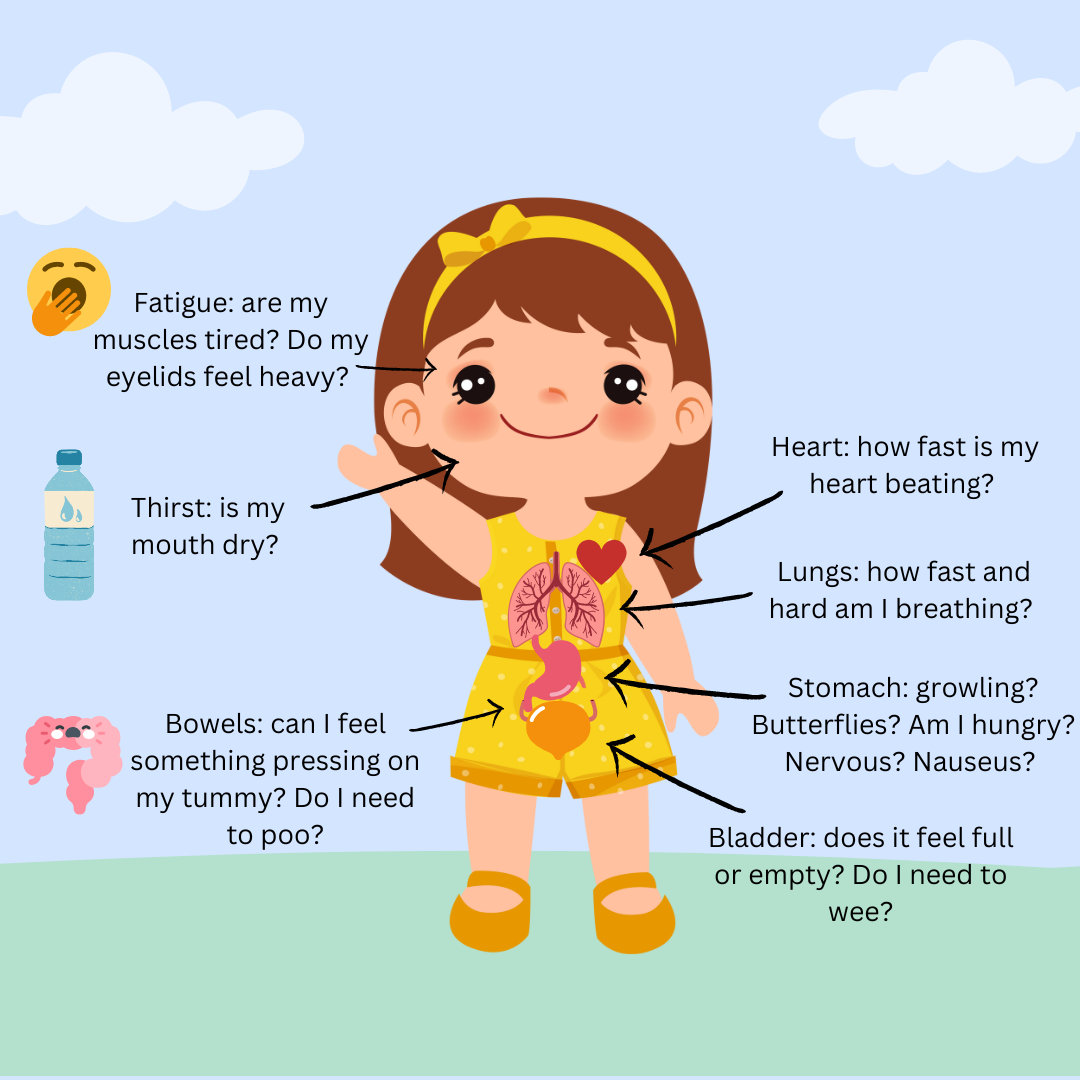Building Body Awareness in Children
Has Your Kid Ever…
Waited way too long to go to the bathroom — or said they didn’t have to go, only to have an accident a few minutes later?
Refused to eat, then had a meltdown — only to say they were starving after?
Seemed “off” but couldn’t explain why — and later, you realized they were tired, overwhelmed, or even cold?
Had a hard time calming down because they couldn’t tell what they were feeling inside?
These might be signs of interoception challenges — that’s the hidden sense that helps us feel what’s going on inside our bodies: hunger, thirst, the need to go to the bathroom, heartbeat, emotions, and more.
When kids struggle with interoception, they might have a hard time knowing what they’re feeling, why they’re feeling it, or what to do about it. This can make self-regulation, potty training, and even daily routines extra tricky.
Here are some OT-friendly interoception activities and ideas to help kids build awareness of their internal signals — like hunger, thirst, temperature, bathroom needs, and emotions. These are great for therapy sessions and home carryover!
What Is Interoception?
Interoception is our "internal body sense" — it helps us notice what's happening inside our body:
“I feel hungry.”
“I need to use the bathroom.”
“My heart is beating fast.”
“I’m feeling overwhelmed.”
Kids with interoceptive challenges may struggle to recognize, interpret, or respond to these cues — which can affect regulation, toileting, eating, and emotional awareness.
OT Inspired Activities:
Body Check Chart
Ask:
"Is your tummy full, empty, or just right?"
"Are you hot, cold, or comfy?"
"Do you feel calm, wiggly, or wild?"
Make a daily habit of asking these questions in the morning, after meals, or during transitions.
Jump & Rest
Jump for 30 seconds
Then sit and place a hand on their chest
Ask:“Is your heart beating fast or slow?”
“Is your breathing deep or shallow?”
Thermometer Walk
Create a pretend “body thermometer” on paper:
🧊 Cold — 😌 Just right — 🔥 Too hot
Ask how their body feels in different places (outside, car, after movement). Use this to practice dressing for the weather too!
Tummy Talk Before & After Eating
“What does your belly feel like before eating?”
“How about now?”
Use words like growly, gurgly, empty, comfy, stuffed.
Bathroom Signals Game
Play “Potty Detectives” — act out different signals:
Wiggly dance
Holding stomach
Crossing legs
Ask: “What might this body be trying to say?”
Emotion & Body Matching
Use feeling cards or emojis and ask:
“When you're sad, what happens in your body?”
“When you're excited, what does your heart do?”
Draw a body outline and color where they feel things (e.g., butterflies in tummy).
Yoga Poses + Body Check
Do a simple pose (child’s pose, downward dog) and then pause:
“Do you feel more calm or more awake?”
“How does your tummy feel?”
“Can you feel your breathing?”
Bubble Breathing
Blow bubbles and watch them pop slowly.
Ask: “What do you feel in your body after blowing slowly vs. fast?”
Use this to help kids recognize when they’re calm vs. dysregulated.
Snack Detectives
Explore snacks with all senses — before eating:
What does it smell like?
What happens in your mouth after you take a bite?
What do your taste buds say?
Inside/Outside Sorting
Make a sorting game:
“Is this a feeling on the outside or inside?”
Examples: hunger, tickle, cold wind, sadness, stubbed toe.
Use pictures, stickers, or objects.
Every child is unique — and so is their interoception system! If you have questions or need ideas tailored to your child’s needs, always reach out to your occupational therapist. We’re here to help support your child’s body awareness, regulation, and confidence every step of the way.
At Creating Connections OT, we’re here to help your child thrive—emotionally, physically, and socially. If this post resonated with you and you're wondering what the next step looks like, our New Client Page has everything you need. From what to expect in your first session to how we support your child’s unique goals, it’s all just a click away.


